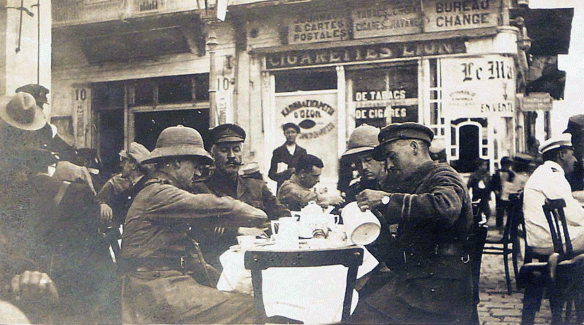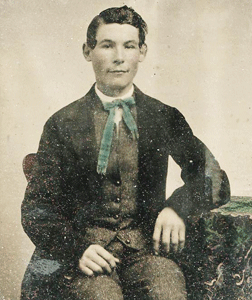
Canadian officers in a photo taken by Ruby in northern France
Nursing Sister Ruby Peterkin’s first surviving letter from the War was addressed to her sister Irene in Toronto from Northern France,probably Rouen. She had been posted to France for 4 or 5 months to serve with the British Expeditionary Force. Ruby shares a tent with fellow nursing graduate Madge (Margaret) McCort, and refers in this letter to two other nursing sisters who were in the Toronto General Hospital class of 1911. Almost every letter includes a plea for family members to send her mail, with her niece Theresa Peterkin urged here to tell everybody to write.
No. 5 General Hospital
B.E.F.
June 20 15
Dear Rene ▬
We have been here a week now and it seems like a month. I sent you a card on Wednesday. Did you get it? I’ll try to tell all about everything. In the first place, our M.O. has promised to censor all my letters and those we receive are not censored, only these we send are liable to be opened at the base post-office at any time.
We are all in wooden huts and our rooms are very good-sized. Madge McCort and I are together. We get up at about 6.30 (or later) a Tommy comes and bangs on our doors. He also sweeps out the rooms later in the days and two of them wait on our table.
Madge McCort
We have breakfast and go on duty at about 7.30. There seems no hard and fast rule about this however. Then at 9 o’clock we come over to the sisters’ quarters again for ‘tidying up’. We usually get a clean apron on there and go into the dining room for tea and biscuits. Then go back on duty and lunch is at 12.15 and 1.15. We have ½ hour for tidying up and ¾ for lunch. Then we have three hours off in the afternoon either from 2 – 5 or 5 – 8. Tea is at 4.30 or 5 and dinner at 8.15. So you see we do not have any chance to reduce. But there is no drinking water. I have been drinking tea five times a day and my teeth are turning black. You can purchase soda-water cider and wine from the house-sister. I have tried them all, but they don’t touch the spot. We are going out on a still hunt for ginger-ale one of these days.
This is Sunday and I have last hours, so Miss Gamble and I came out to the woods, bringing rugs and cushions. On the way we picked up a sick-kids nurse so we are all here now. You see there are 40 of our units all around here — at No. 6 and No. 9 right next us and at 10, 11 & 12 quite near too. Then Daisy Dean, Neil Dow and Ted Fraser are at No. 8 away across at the other side of the town. We were out to see them last Tuesday for we did not go on duty until Wednesday.
It is not at all busy at any of the hospitals just now, and they were not at all glad to see us when we arrived. In fact I fear the Eng. sisters do not love us. You see we have two stars and they hadn’t, and although they spend a great deal of time in assuring us that they “rank as officers” it is not as convincing as those two stars. We just calmly survey their uniform which is hideous – a grey chambray apron like ours and a little grey cloth cape edged with scarlet about two inches. Then we as calmly glance at our own, which believe me looks pretty smart in these surroundings, and you can fairly see them turn green. They freeze us entirely, most of them, but it does not seem to have much effect for I think we have a better time than they do. The nursing is punk, in fact is not nursing at all. We were in the Gen. Hospital in Boulogne and the difference between it and this was very striking. The Tommys ask to be sent to the Can. hosps. every time.
We have not had much opportunity to go about to see things yet, but I hope to on our half day. You see we are in the valley of the Seine River and there are hills all around. The woods where we are are beautiful, all tall straight pines and it seems very extensive. They say Wm. the Conqueror used to hunt in them.
There are numerous camps of British in the neighborhood. Madge and I have decided we cannot get around without a car, so we are looking for a cheap Ford. The car into town is about a mile and a half away. We go into town to the Normandy on our hours off. This is a restaurant much frequented by British officers and sisters and we go whenever possible. There is no place else to go. We have to be in by eight every night.
I have not had any mail since the day before I left London. I hope it will find its way here next week.
My pen is on the blink. Tell Theresa and everybody to write to me. I have not heard fromany of them. Write and tell me where you went. I keep wondering if you are up north or where.
Yours ever,
Ruby

There is a bath-tub but only cold water.























 Back in the summer of 1953 I visited Scotland for the first time. On my own I joined a Thomas Cook bus tour and was thrilled to learn that we would spend a night at Huntly Castle Hotel which we were told had been built in the 1700s by George, Duke of Gordon, of stones retrieved from the old ruined Castle nearby. And lucky me I had the chance to spend the night in a murdered Duchess’ four-poster canopy bed.
Back in the summer of 1953 I visited Scotland for the first time. On my own I joined a Thomas Cook bus tour and was thrilled to learn that we would spend a night at Huntly Castle Hotel which we were told had been built in the 1700s by George, Duke of Gordon, of stones retrieved from the old ruined Castle nearby. And lucky me I had the chance to spend the night in a murdered Duchess’ four-poster canopy bed.
